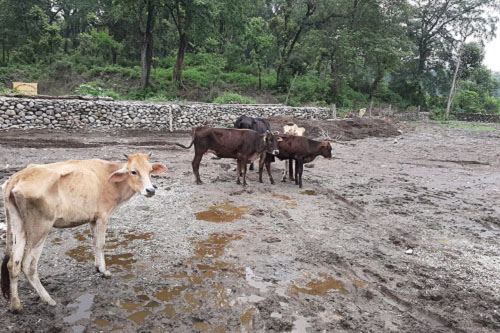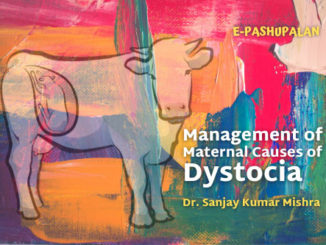Introduction
Oestrus is defined as a type of sexual behaviour near the time of ovulation which is characterized by the acceptance of the male. Anoestrus indicates the lack of this typical oestrus expression at an expected time. It is a normal phenomenon in association with some physiological conditions, but becomes pathological when the duration exceeds the generally accepted average. In fact, post-partum anoestrus can be defined as the lack of oestrus symptoms (despite of effective oestrus detection) within 60 days after calving, while normal cows in exactly the same conditions already have been seen in heat. Longer postpartum anoestrus exhibited by bovines might be due to low secretion of luteinising hormones during this period. Physiologically post-partum anoestrus cannot be escaped because it is helpful in involution of uterus within 15–45 days after parturition most of the dairy cows recommence heat. One of the annoying problems in dairy industry is postpartum anoestrus. So current review detailed on “post –partum anoestrus in dairy cows”.
Etiology
Nutrition: In India like tropical country, the dairy cows are habitually reliant on field grazing and by-products of seasonal crops for feed. This kind of the feed stuff have below 7.5% crude protein, so rumen efficiency is decreased and true digestibility of the feed also moderated. There is consequently a direct correlation between negative energy balance and a reduction in the release of gonadotropin releasing hormone. Thus indicating that nutritional deprivation decreases GnRH pulse frequency by enhancing hypothalamic inactivity. High lactation demand is positive correlated by means of intake of dry matter and energy that cause deviation in energy balance in postpartum cows.
Lactation: In high yielders prolactin hormones secreted more which cause negative effect on GnRH secretion. Finally it causes anoestrus due to insufficient FSH and LH hormones.
Suckling: During suckling teat it generate physical stimuli which cause release of endogenous opioids like endorphins. These opioids act as neurotransmitters through central nervous system and inhibit the release of luteinizing hormones. Suckling influences the length of the postpartum interval anoestrus in cows. Regulation of the suckling and lactation stimulus is a viable management option to decrease the post-partum interval and this can be achieved by complete, short-term (48 h) or partial (restricting suckling to short periods of time each day) weaning.
Season: If calving has taken place in winter season, dams are prone to maximum threat of anoestrus. Seasonal change in photoperiod cans stimulation in brain and dairy cattle’s are not seasonal breeders.
Breed and Parity: Suckled dairy cows have longer postpartum interval than suckled beef cows. Primiparous cows have longer intervals to first ovulation than multiparous ones and cows with lower energy balances have longer intervals than those with higher energy balances.
Stress factors: Especially thermal stress during gestation has an effect on subsequent lactation and reproductive efficiency resulting in anoestrus after parturition due to altered endocrine status. Types of Anoestrus
There are four different clinical forms of anoestrus namely
- Silent heat
- Cystic ovarian disease
- Ovarian a function (hypo-function)
- Corpus luteumpseudo graviditatis
1. Sub oestrus
It is unobserved or silent heat. Cows suffering from sub oestrus are not seen in heat at the expected time after parturition although they are cycling regularly, as can be proven by progesterone profile analysis and rectal examination. Sub oestrus is the main reason why cows are not seen in heat within 60 days after calving.
2. True anoestrus
Cows in true anoestrus are characterized by low progesterone levels in milk and blood and inactive ovaries or ovaries with poor follicular growth. Prolonged periods of ovarian quiescence and anovulation are mainly due to lowered plasma LH levels. As a consequence, factors that suppress LH pulse frequency during the post-partum period will delay the first ovulation and lead to anoestrus. Although many stress factors are known to impair oestrus in the dairy cow by reducing the LH pulse frequency, it is generally accepted that malnutrition and an excessive Negative Energy Balance are the main causes of delayed ovarian function after calving. Decrease in plasma LH levels caused by a lowered sensitivity of the pituitary to GnRH stimulation.
3. Pyometra
Pyometra is characterized by a progressive accumulation of pus in the uterus in the presence of functional ovarian luteal tissue, usually a corpus luteum or rarely a luteal cyst. During parturition the uterus is invaded by several kinds of bacteria like Gram-negative anaerobic bacteria (especially Fusobacterium necrophorum and Bacteroides melaninogenicus) and Actinomyces pyogenes. In cows with disturbed uterine defence and involution processes, as after a retainedplacenta, the self-clearance mechanism of the uterus can be perturbed. An exudative purulent response is generated in the endometrium and the ability of the uterus to produce or transport a sufficient amount of prostaglandins to cause luteal regression is compromised. As a result, the corpus luteum persists and since the genital tract remains under the continuous influence of progesterone without an intervening oestrus, the infective process progresses and a purulent exudate accumulates in the uterus. Cows which suffer from pyometra show little or no signs of ill-health. The main reason for them being examined is the absence of cyclic activity and sometimes the presence of an intermittent vaginal discharge. The diagnosis will be based on the anamnesis and on anextensive clinical examination.
4. Cystic ovarian disease:
Another common pathological condition leading to post-partum anoestrus in dairy cows concerns cystic follicular degeneration or cystic ovarian disease (COD). Cows are diagnosed as being affected by COD when they have one or more fluid-filled ovarian structures (cysts) of at least 2.5 cm in diameter that persist for at least 10 days in the absence of a corpus luteum, combined with cyclic irregularity characterized by anoestrus or nymphomania. Pathological ovarian cysts (follicular cysts and luteal cysts) arise as the result of anovulation of follicles. Cystic Ovarian Degeneration (COD) in dairy cattle occurs most frequently during the early post-partum period (30 to 60 days after calving), at the time of resumption of normal ovarian activity.
5. Pregnancy
It should be kept in mind that also pregnant cows do not cycle and will not be seen in heat. Especially in herds with a poor management and in those in which a bull has entrance to the cows, attention has to be paid to pregnant cows.
Diagnosis
Diagnosis will be based on the anamnesis, a general clinical examination, and an accurate gynaecological examination based on rectal palpation of the ovaries and the tubular genitalia, although rectal palpation is a valuable and cheap technique, more accurate techniques such as ultrasound imaging or progesterone analysis in milk or blood are required.
Treatment and prevention
Cows which are diagnosed to be in sub oestrus and which have a well-developed corpus luteum should be treated with prostaglandins. Treatment of these cows will bring up to 80% off the animals into a fertile oestrus within 2 to 6 days, depending on the stage of the cycle in which they were treated.
If pyometra is diagnosed, the first choice of treatment is an injection with prostaglandins. This treatment causes regression of the corpus luteum persistens and induces oestrus and ovulation, which leads to the evacuation of the abnormal uterine content and an enhancement of uterine defence mechanisms. Relapses often occur; it is therefore advisable to treat these patients a second time with prostaglandins 12 to 14 days after the first treatment. Insemination can be started after endometrial lesions have healed, which takes 1 to 3 months.
Lack of LH is the primary cause of COD, general treatment of cows affected by COD is directed to stimulate luteinization of the cyst, which is usually followed by the reestablishment of a normal oestrous cycle. Biological preparations high in LH-like activity (e.g. human chorionic gonadotrophin) and exogenous GnRH, which acts on the pituitary gland to cause the release of endogenous LH, have been widely and effectively used for the treatment of both follicular and luteal ovarian cysts. Almost 80% of the affected cows exhibit a fertile oestrus within 16 to 30 days, although pregnancy rates are slightly lower in comparison with those of normal cows. Cows suffering from true anoestrus or inactive ovaries are the most difficult to treat.
Therapy should be approached first by correcting underlying nutritional deficiencies or systemic diseases. Prevention of deep Negative Energy Balance (NEB) and Shortening or eliminating the dry period may improve energy status of cows and increase reproductive efficiency. Prevention of metabolic diseases in the peri parturient period heat stress and management factors would reduce the incidence of Anoestrus. Finally, early diagnosis of pathological conditions (e.g. chronic debilitating diseases or uterine and ovarian diseases) should be done and proper treatment should be given.
Conclusions
During the past 50 years, there has been considerable advancement in our ability to intervene in the reproduction of cattle. However, fertility in dairy cattle has consistently declined, despite increasing veterinary intervention. A major factor that determines the initiation of ovarian activity and allows the animal to maintain cyclicity is postpartum energy balance. It is more effective to prevent rather than treat anoestrus. Although the appropriate use of hormones does not have any known negative effects on animal welfare or public health, the concern of consumers regarding treatments must be considered. We need to focus on improving animal health and fertility by promoting good management rather than by relying on the widespread use of exogenous hormones.







Be the first to comment